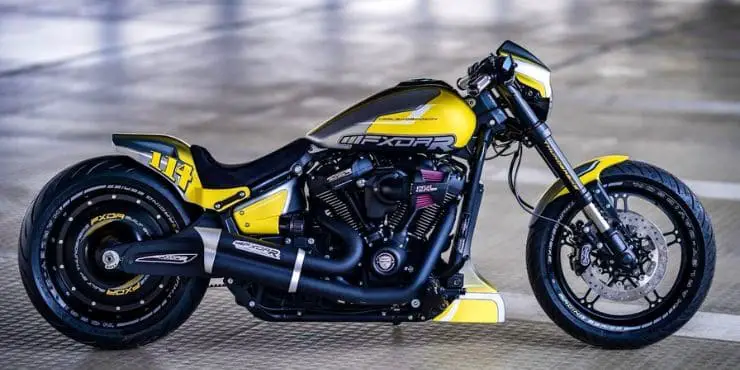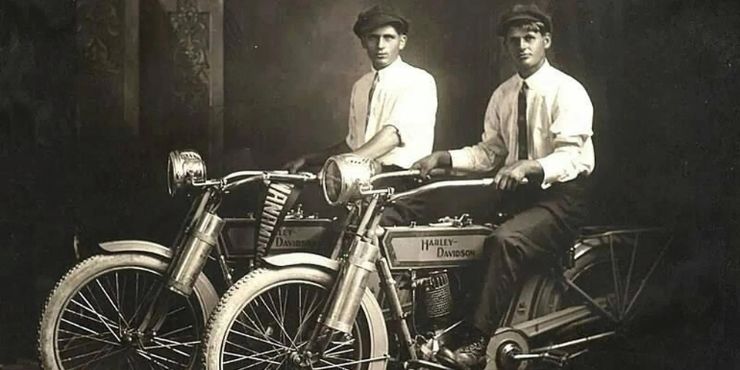Do you own a Harley-Davidson bike, and you’re curious to know the history behind it, and how did it start? If yes, then this is the right place for you to be.
Harley-Davidson started in 1903 when William S. Harley and Arthur Davidson built their first motorcycle in a small shed in Milwaukee, Wisconsin. Their goal was to create a reliable motorcycle for personal transportation.
In this article, you will get to know about the early beginnings of Harley-Davidson, how did Harley-Davidson start, the evolution of the Harley-Davidson lineup, and more. Stick around to get all the answers that you’re looking for.
How did Harley-Davidson Start
Harley-Davidson is one of the most iconic brands that is matched by very few. But where did the story of Harley-Davidson really begin? Harley-Davidson has enjoyed a lot of success over its almost 120-year history, but the brand has very interesting roots.
If you had to guess, you’ll say that the brand was started by someone named Harley and his fellow partner, Davidson. If you did, you’d only be half right. Harley-Davidson was actually founded by William Harley and the three Davidson brothers (Arthur, Walter, and William).
The early beginnings of the brand go all the way back to the late 1880s to two houses on 9th Street in Milwaukee, Wisconsin. William S. Harley and Arthur Davidson were only one year apart in age and grew a few houses from each other. Just like most boys of that era, they were intrigued by the new form of two-wheeled transportation – the bicycle. In fact, William Harley became so intrigued by bicycles that he took a job at the Milwaukee-based bicycle factory aged just 15.
By the turn of the century, he had already managed to work his way up from being a cycle fitter to a draftsman. He left the company and started working as a draftsman for the Barth Manufacturing Company. It was during this time that he designed his first internal combustion engine, which was based on the French de Dion-Bouton engine. It was used and copied by many early motorcycle manufacturers. With the help of Arthur Davidson, who was also a draftsman at Barth, and a mutual friend whose father owned a lathe, William spent the next couple of years completing a prototype machine in his spare time.
The first motorized bicycle did not actually materialize, but Harley had already started putting his draftsmanship skills to use. By 1903, he had created the second prototype. William and Arthur eventually realized that they required a competent machinist to come up with a complete prototype. They decided to enlist the help of Arthur’s brother, Walter Davidson. Walter was an experienced machinist who was working at the Milwaukee Railroad, but residing in parsons, Kansas at the time.
To convince Walter to come, the two aspiring draftsmen sent him a letter stating that they had already built a motorcycle, and they were saving the first ride for him. Once Walter arrived, he found that they were nowhere close to having a properly assembled bike. Instead, it was a pile of different parts. However, this idea of a two-wheeled bicycle that was self-propelled appealed to Walter. He chose to stay and help them build their first motor bicycle.
Soon after that, William Davidson also joined the group. William was a toolroom foreman and a mechanic for West Milwaukee shops. His skillset turned out to be a great asset in developing their first bike. With the last piece of the puzzle arriving, the construction of the first Harley-Davidson motorcycle started in a small wooden shed in the backyard of Davidson’s home.
Most of the motorcycles on the road during the early 1900s were just motorized bicycles. Even Harley-Davidson’s soon-to-be-rival, the Indian Motorcycle Company also used a bicycle-style frame with an under-powered motor. William took note of this and looked at the loop frame design used by fellow Milwaukee motorcycle manufacturer Merkel. Harley-Davidson took inspiration from the Merkel frame and released its own designs, building the first Harley-Davidson prototype using a loop frame and a 440cc single-cylinder motor.
The second prototype was completed around 1904, and it is still seen in the Harley-Davidson museum in Milwaukee until now. The prototype is popularly known as the Harley-Davidson Serial #1. It was also the first Harley-Davidson motorcycle to be documented as participating in a motorcycle race.
Harley-Davidson was finally incorporated in 1907 and the brand has never looked back since. Walter Davidson was chosen to be the first president of the company. Arthur took over the job title of general sales manager and secretary. The eldest brother, William Davidson, was made the works manager. Meanwhile, William Harley took on the position of chief engineer and treasurer.
The First Harley-Davidson Bike – A Bicycle with a Motor
At its core, the first Harley-Davidson bike was basically a bicycle with an engine. The first Harley-Davidson bike created was a bike with a slightly modified frame that made the engine easier to mount. A leather belt was used for carrying power from the engine to the rear wheel. This bike had pedals, which allowed the biker to pedal it like a bicycle if they wanted to. It even featured a normal coaster brake in the rear hub that could be applied with the pedals (by pedaling backward) as you would on a normal one-speed bicycle today.
The original Harley-Davidson bike featured a 24.75 cubic inch (405 cc), single-cylinder, air-cooled engine that had an F-head valve configuration. The bike’s engine weighed around 49 pounds. The Harley-Davidson bikes today don’t really look like a bicycle. The motorcycles of the past and the motorcycles of today both have two wheels. But this is where the similarities end.
For instance, take a customized Harley-Davidson as an example. An average Harley-Davidson bike today features an engine that is 88 cubic-inch (1,450 cc), two-cylinder engine. They’re arranged in the V-twin configuration with a 45-degree angle to the V. The engine makes use of dry sump lubrication and the external tank for the oil mounts above the transmission. The exhaust is a pair of stainless-steel pipes that are connected to the exhaust port of each cylinder.
The transmission sits behind the engine, while there’s a 6-speed sequential manual gearbox. The engine transmits the power from the crankshaft to the transmission through the primary drive. The power will then move from the transmission to the rear wheel through the final drive, which here is a chain. All the engine’s power will end up going to the back wheel.
There is also a rear disk brake and the back portion of the frame. The Harley-Davidson motorcycle frames of today are basic. The frame is simply a few steel tubes bent and welded together. For hard tail bikes, there are no rear suspensions, hence the name. Meanwhile, the front form, the suspension component of today’s bikes is located at the front end of the motorcycle.
The front wheel is slightly smaller than the rear, while there is also a single disc brake at the front. The front fork will be able to compress to easily absorb shock. At the front of the front fork, there are the headlight and the handlebar.
Certainly, the Harley-Davidson models today are not as simple as the first Harley-Davidson bike, but they aren’t super-complicated either.
Evolution of the Harley-Davidson Product Line
Since Harley-Davidson was established as a brand, there have been hundreds of different and exciting Harley-Davidson models and variations. However, if you’re looking for the bikes that are the essence of this brand, then there are some particular models released over the years. As Harley-Davidson has evolved, the brand has released a long line of exciting models.
Harley-Davidson Sportster
The Harley-Davidson Sportster is Harley-Davidson’s entry-level bike. This model is lighter and sportier compared to most Harley-Davidson models, hence the name. The 2003 Sportster comes in seven exciting variations. This bike is 88-inches long, weighs around 500 pounds, and has a price of around $7,000 or so.
Harley-Davidson Softail
The Harley-Davidson Softail is a general-purpose motorcycle. It is around 95-inches long and it weighs 650 pounds. The bike comes in different variations and the prices fall between $14,000 and $19,000. Some of the recognizable names in this lineup are the “Fat Boy”, the “Deuce”, and the “Springer Softail”.
Harley-Davidson VRSC
Harley-Davidson VRSC is currently the only production bike that makes use of the Revolution engine. The bike is about 94-inches long, and it will weigh around 600 pounds. The motorcycle is priced at around $19,000.
Harley-Davidson Dyna Glide
The Harley-Davidson Dyna Glide is a classic Harley chopper, and it is 94-inches long. The bike weighs around 630 pounds and the prices range between $13,000 and $18,000.
Harley-Davidson Touring bikes
The Harley-Davidson touring bikes include the iconic “Road King”, “Electra Glide”, and “Ultra-Classic”. These motorcycles are 94-inches long and weigh between 700 pounds and 800 pounds. These motorcycles have saddlebags as well as other touring trim. The prices start at around $15,000 and go as high as $22,000.
Customization and Aftermarket Prospect of Harley-Davidson Bikes
Even though the initial Harley-Davidson were quite good and bikers loved the bikes in their pure form, a strange change has taken place in the Harley-Davidson marketplace over the years.
Similar to how many people prefer customizing their cars, many bikers have started customizing their Harley-Davidson bikes. The customizations can be quite simple from putting on a different exhaust system to radical, like adding chopper-style forks.
The supply of parts for customization is known as the aftermarket. There are hundreds of brands that produce and sell aftermarket Harley-Davidson parts.
Over time, the Harley-Davidson aftermarket has grown tremendously. The companies today produce every single part found on Harley-Davidson models in multiple forms – engines, frames, transmissions, brakes, forks, wheels, brakes, gas tanks, and more. All these components can be easily purchased in the aftermarket.
What this means is that you’ll be able to go to the suppliers, buy all the parts that you need, and then assemble your own Harley-Davidson bike using off-the-shelf parts from scratch. You can purchase an aftermarket engine, aftermarket wheels, an aftermarket transmission, and so on. Once you have everything at your disposal, you can create a very different and customized version of a Harley-Davidson bike.

Cyborg Cycles is a reputed aftermarket supplier, and it is the perfect example of brands that sell you all the aftermarket parts. Brands like this cater to the build-your-own marketplace. You can even purchase complete motorcycle kits, including every part you need to assemble an entirely different bike. If you haven’t customized your bike before, a motorcycle kit can take a lot of the guesswork out of your hands and drastically improve your chances of success.
You literally do anything and everything that you want in the Harley aftermarket. You can spend anywhere from a few hundred to a few thousand to make your bike as customized as you want.
FAQs
What was the first Harley-Davidson motorcycle called?
The Harley-Davidson Model 1 was the first bike produced by the iconic American manufacturer Harley-Davidson.
How did Harley-Davidson get its name?
There is an interesting story behind how Harley-Davidson got its name. Harley-Davidson was started by three Davidson and one Harley. Even though the ratio was 3:1, it was agreed that William Harley’s name should go first, as he was the one who came up with the original idea of building a motorized bicycle.
Is Harley-Davidson the oldest motorcycle company?
No, Harley-Davidson is not the oldest motorcycle company, as this distinction goes to Peugeot Motorcycles. In 1898, Peugeot Motorcycles presented the first motorcycle equipped with a Dion-Buoton motor at the Paris Motorshow.
What makes Harley-Davidson bikes so special?
Harley-Davidson bikes are powerful, and they are built to last. With their durable assembly coupled with revolutionary engines, these motorcycles are incredibly durable. Further, most of the Harley parts are easily replaceable, which means that you can easily purchase new parts when they become damaged or worn out instead of having to purchase a new bike.

